THE EXPERIENCES AND
OBSERVATIONS OF
A CANADIAN SPITFIRE PILOT IN
WORLD WAR II
By Mr. Stephen Butte, DFC, BASc., P.Eng, and
Honorary Colonel of 403 (Helicopter)
Operational Training Squadron CFB Gagetown,
New Brunswick, Canada
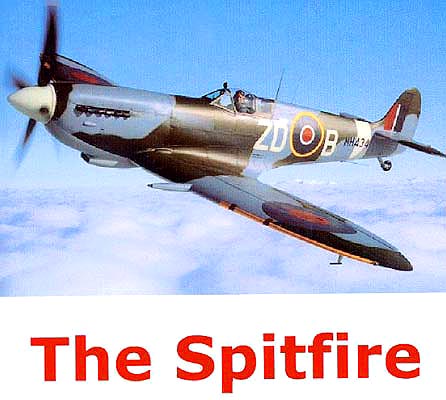
THE EXPERIENCES AND OBSERVATIONS OF
A CANADIAN SPITFIRE PILOT IN WORLD WAR II
By Mr. Stephen Butte, DFC, B.A. Sc., P.Eng, and Honorary Colonel of 403 (Helicopter) Operational Training Squadron CFB Gagetown
This is a transcript of an address given by Mr. Stephen Butte,
DFC, B.A. Sc., P.Eng as a guest speaker at a Remembrance Day
ceremony and dinner held at Halifax Royal Canadian Legion Scotia
Branch 25 by the Nova Scotia Aircrew Association on
November 6, 2001.
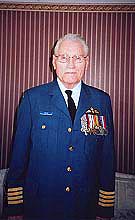
|
Ladies and Gentlemen,
Since the end of World War II, I have had
little contact with previous wartime acquaintances and have always
worked as a Civil Engineer on construction. Summertime was always
the busy season and not the time to attend reunions and to make
visits back to Europe, hence I literally disappeared from the
reminiscing scene. My work took me to isolated areas of BC and
the Yukon, usually starting from a wilderness setting to a
completed project and/or industry, and when completed
it was time to move on to another wilderness setting in pivotal
resident engineering positions.
Some of my projects were: Alcan`s Nechako Kitimat and Kemano Hydro Electric Development: BC Hydro`s Mica Dam and associated works: [Mica Dam is the eleventh highest earthfill dam in the world]: Aishihik power development in Yukon: Denison Mines [Quintette] Northeast Coal development at Tumbler Ridge: BC Hydro’s Site C investigations on the Peace River for further hydro-electric development, and studies relating to development of possible power projects on the McGregor, Stikine, Atlin, Taya and Taku rivers in North West British Columbia and Yukon .
I moved to Nova Scotia in July of 2000, and had my first involvement in ex air force activities when I joined the Nova Scotia Air Crew Association and met the members who were primarily ex bomber crews, some of whom had been prisoners of war under the German regime. They graciously accepted me as a member although I was a bit of a rarity in these parts, a surviving Spitfire pilot; and my story unfolds as follows:
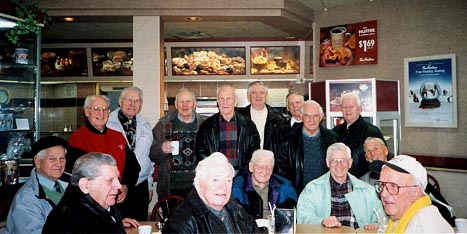
Some of the Nova Scotia Air Crew Association, consisting of Pilots, Navigators, Air Gunners, some of whom were Prisoners of War in WWII. |
Aircrews in the RCAF evolved from extensive
training under the British Commonwealth air-training plan that
took place in Canada. In 1942 the academic pre-requisite to
becoming a navigator or pilot was a University entrance certificate.
I acquired this in May 1941 but had to wait until November when I
reached the age of 18 to be eligible for enlistment. In January 1942,
I enlisted in Calgary and then started the training plan program of
manning pool, initial training school, elementary and service flying
schools, which ended with the awarding of wings in March 1943. A fast
trip to the United Kingdom via the Queen Elizabeth (I) from the Cunard
Terminal in Halifax was made in 1943 along with about 18,000 other
members of the forces. At Advanced Flying Unit in the United
Kingdom, Miles Masters were flown as the transition aircraft
between Harvards and Spitfires, which were the aircraft flown at
Operational Training Unit, also in the UK.
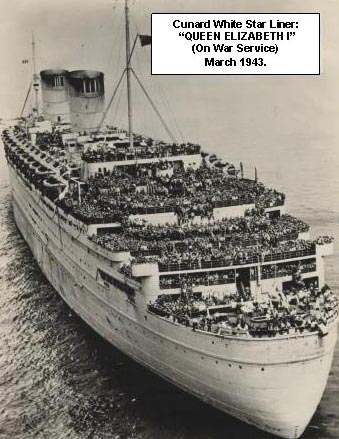
|
Spitfires are a single
engine aircraft with no provision for dual instruction in the air.
They were considerably more powerful than any aircraft heretofore
flown by any of the students and novice pilots were usually miles
from base before they got the undercarriage raised.
The undercarriages
of early Spits did not have motorized hydraulic systems and had to be
pumped up using a hand lever. This resulted in a comical performance
when the aircraft responded to simultaneous motions of the left arm on
the control column and the right arm on the undercarriage lever,
giving a departing aircraft a porpoising flight path.
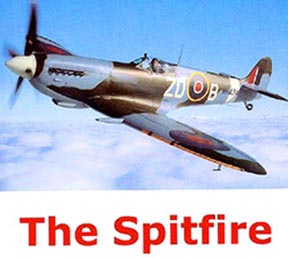
At the time of my induction, we were waiting for D-Day to happen and we spent almost a whole year traversing the United Kingdom getting further training ad nauseam in bombing, gunnery and aerial combat. Finally in June 1944, I was assigned to 403 Squadron, City of Calgary, at Tangmere, and when our airfield B2 at Crepon on the beachhead after D-Day was readied, we moved there and proceeded to support our ground forces by attacking anything that the enemy was attempting to move to the front to support the defending German forces.
We had substantial mastery of the air and the
Germans complained that we attacked trucks, tanks, motorcycles,
even personnel and they said that trying to smuggle anything to
their lines was like trying to sneak a sunrise past a rooster. During
the early stages of the invasion, the navy stood offshore and lobbed
shells at the enemy lines and over the top of our airfields, so we
accessed our airfields by flying low across the east end of the
beachhead where numerous swamps had fewer anti-aircraft guns and
no navy shells. The Luftwaffe appeared only infrequently but
when they did, they arrived in large numbers and half a dozen
Spits often had to deal with thirty or forty Messerschmitt 109`s
and/or Focke Wulf 190`s. Even at these odds, some of our pilots
managed to accrue handy scores against them.
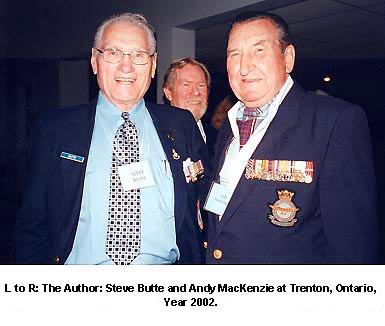
|
One such pilot was Andy Mackenzie with whom I formed a fighting team. Andy was our Number One and it was his job to shoot down the enemy aircraft when encountered, and it was my job as Number Two, the wingman, to ensure that nobody sneaked up behind us and shot us down. As a team we shot down over four enemy aircraft, but unlike hockey where they give assists, in combat only the guy that does the shooting gets the plaudits, and the Number Two is just an also ran. In one encounter with enemy fighters, I informed Andy that we were being attacked from the rear and he should discontinue his attack on an aircraft. Instead of heeding my warning, he continued to blast away at the aircraft and while delivering a couple of extra bursts at his quarry, a German aircraft that was on my tail was doing the same to me.
Andy did not get his quarry but cannon and machine gun bullets struck my aircraft, destroying my flap and brake systems, and a section of my left wing was blown off when the ammunition in my 20 mm cannon magazine exploded. From the pursuing German fighter, I received a hit in the tail section of my aircraft and a high explosive cannon shell exploded behind the armour plating at my back, and shrapnel fragments penetrated my leather helmet and caused a little bleeding. The ammunition in fighter aircraft was usually loaded into flexible belts with one armour piercing shell followed by a high explosive shell and so on along the belt, or any other sequence, depending on the intended targets if they could be anticipated before flight. Armour piercing shells produce holes, whereas high explosive shells produce shrapnel and fires if there is anything combustible around. Fortunately for me, the hit I received was from an explosive shell and not an armour piercing one, which could have penetrated the armour plating, located behind the pilot’s seat in a Spitfire. Throughout all of this action, the trusty Rolls Royce Merlin engine purred on, and I landed at my base without flaps or brakes.
Andy completed his tour shortly thereafter and I became my own Number One. Andy Mackenzie has the dubious honour of having been shot down twice, once by friendly American flak on the beachhead, and once by a friendly American aircraft over Korea where he spent two years as a prisoner of war. Andy is often seen on TV at the Remembrance Day services on Parliament Hill and other auspicious occasions. Look for him this time. He usually wears a wedge headwear and is accompanied by a silver haired lady who I presume is his wife.
Our daily routine of armed reconnaissances continued when weather permitted. These were armed intrusions into enemy territory to attack anything and everything that might have had military value to the enemy, including tanks, trains, trucks, roads, bridges, even dispatch riders on motorcycles, and other personnel. Before the Allied invasion on 6th June 1944, pressure was applied by the Russians for the Allies to harass the Germans on the western front to remove some of the pressure that the Germans were applying to them on the eastern front. The Allies obliged by sending armed fighter patrols to France, Belgium, and Holland as far as the ranges of these aircraft could be extended, and since these intrusions, then known as rodeos, ramrods, rhubarbs and circuses originated in England, two water crossings were involved in a successful mission.
Even a minor engine problem or a hit from enemy fire often prevented a safe return to base, and many of our experienced pilots were lost in these raids. The cost therefore was very high and in the final analysis, these raids were of questionable value, except to appease the Russians. When we were established in France after D-Day, the two flights over water were eliminated, but our jobs remained the same. We sometimes carried bombs and I recall one such mission, which lasted a total time of ten minutes. Our bombs were dropped onto a patch of forest where Tiger tanks were sheltered and our target was identified by our artillery using coloured smoke. This operation was performed in collaboration with Typhoon aircraft, which were armed with rockets as well as cannons.
Highlights of our operations occurred in 1944 at Grave, Holland near Nijmegen, when the Messerschmitt 262 jets arrived on the scene. From an altitude of about 20,000 feet, they dropped canisters of fragmentation bombs which were programmed to explode at about 1,000 feet above ground level, emitting a loud "poof", and at the same time some 69 baseball sized bombs were thrown in all directions which in seven seconds struck the ground, and spewed fragments of hot metal against aircraft, facilities and personnel.
One of the most satisfying of our armed reconnaissances was one that I triggered by detecting a large fuel convoy disguised by camouflage in a patch of forest. The convoy was substantially destroyed by our Squadron (403) and must have been missed sorely by Rommel and his Panzers further up the line at Caen, where a stalemate in the fighting against the British and Canadians had developed. The Battle of the Falaise Gap resulted in the substantial destruction of Rommel`s armour in Normandy. Rommel himself was wounded by a flight of marauding Spits while driving in his staff car on July 17th . While still recovering from his wounds, he was implicated in the bomb plot against Hitler and was coerced by Hitler to poison himself instead of facing a trial. I flew on the 16th and 18th, but not on the 17th.

|
A humourous anecdote worth telling was the day the interdenominational padre was sitting on the throne of an outhouse privy and one of the "poofs" occurred. With only seven seconds to make a big decision, he chose to go down the hole rather than face his destruction by the anti-personnel bombs.
The ground crews, personnel who maintained,
refuelled and re-armed the aircraft, dug trenches near the
aircraft so they could duck into them when the "poofs"
occurred. Our losses from these bombs and from aircraft taxiing
into trenches were becoming excessive so we were relocated to
Brussels Evere in mid October 1944. [There were several
airfields at Brussels and the one at Evere was discussed
in detail in books regarding the German attack on Allied
Airfields and also the history of their famous fighter group
JG 26]. Another reason we had to leave the airstrip at Grave,
Holland [a grass covered field] because heavy rains flooded
it and it was not possible to differentiate between a pool
of water on the surface and a trench three or four feet deep,
and aircraft often taxied into the latter.

|
On Christmas Day 1944 during the German’s Ardennes Offensive – the famous Battle of the Bulge, we intercepted three of the enemy Messerschmitt Me 262 jet bombers from KG 51 on their way to bomb our airfields and destroyed one. This was another 'also ran' performance on my part, and although the film from my Cine Camera record showed strikes against the aircraft and the Luftwaffe pilot Hans Meyer bailing out, others took credit for the kill. [Cine Cameras recorded the action whenever our guns were fired. Hans Meyer died next day from wounds incurred in this event].
During the autumn of 1944, the Germans, in great secrecy, mustered every available fighter aircraft in an attempt to inflict heavy losses upon the Allies by attacking many of the Airfields in Holland, Belgium and France. The attack was planned for New Year’s Day, 1945, when the Allied Pilots were supposedly hung-over from their New Year’s Eve celebrations.
Code named Operation Bodenplatte (the German word for Base Plate); the New Year’s Day attack achieved almost complete surprise at most of the 23 Allied airfields they attacked, and with total surprise at our airfield at Evere. Both sides lost many aircraft and while the Allies replaced their losses swiftly, the Germans could not replace theirs, and especially the experienced pilots lost.
At about 9:20 AM on New Year’s morning 1945, at the ripe old age of 21 years, plus two months, minus six days, I was taking off on a dawn patrol into a total "overcast of aluminum" comprised of hordes of enemy Me 109's and FW 190's. Since we were 20 minutes from enemy territory, disbelief in what was before me was erased when I saw the unmistakable black crosses on the wings and fuselages and swastikas on the tails of the aircraft ahead of me, and I saw my cannon strikes on some of them. There was no time to reflect or try to keep score against such tremendous odds. Avoiding collisions and dodging debris from some of my victims kept me fully occupied. I do not know how many of them I might have winged when I fired into this large mass of planes -- estimated about 60 aircraft over a small aerodrome going in all directions with guns blazing -- and I still wonder how many might have succumbed on the long way back to their bases.
According to the enemy versions of the attack, the attacking pilots had not seen me and my Number Two taking-off. They were concentrating on trying to destroy other Spits that were taxiing to the runway for take off, or those that were parked in neat rows at the various squadron dispersals. We were negligent in not anticipating an attack of this sort and magnitude, and the aircraft on the ground suffered severe losses. In the melee, my extra fuel tank refused to jettison and it probably impeded the performance of my aircraft, but on the plus side it's refusal to jettison probably saved the lives of our Group Captain, "Iron Bill" MacBrien, and our Wing Commander, Johnny Johnson, who were just leaving the Officer's Mess after breakfast. The mess was on the flight path of my aircraft and by not being hit by my fuel tank, they were able to record events as they transpired. Our Squadron Leader, Jim Collier, also observed the action from the ground and he reported that I had started shooting before my undercarriage had been retracted, usually the first operation after take-off.
I ran out of ammunition after I shot down three of them, but was then attacked by two Focke Wulf 190 Doras -- long nosed versions of the 190`s – with inline as opposed to radial engines -- who were bound and determined to get themselves a Spitfire that day. But by some fancy footwork on my part, I was able to evade them. At one stage, I was within 20 or 30 feet of one of the 190's and contemplated breaking off his tail with my wing but decided against it when I remembered that a second aircraft was back there somewhere. More fancy footwork on my part, and when the two of them were ahead of me, I made my escape. The attack was all over in 10 minutes, but present day historians are still actively researching the records and memories of the still surviving German pilots who were there. Like us, Alzheimer’s, Parkinson’s, etc have taken their toll, and there are not many left after almost 60 years. Other members of the 403 squadron, returning from patrol, got into the fringes of the battle, and three of us got 6 of the attackers.

|
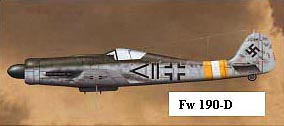
|
For my performance on New Year’s Day, 1945, I was awarded the Distinguished Flying Cross, and my citation is recorded in the Air Ministry Archives in London, and may also be seen on the Internet under RCAF Personnel, Honours and Awards, 1939 to 1949. My citation reads as follows:
" One morning early in January 1945, Flying Officer Butte was detailed to fly the leading aircraft of a section on a sortie over the battle zone. Just as the formation became airborne a large force of enemy fighters attacked the airfield. Flying Officer Butte immediately engaged one of the enemy aircraft shooting it down. A second and yet a third attacker fell to his guns before his ammunition was expended. He was himself then attacked by two fighters but outmanoeuvred them. In this engagement against a vastly superior number of enemy aircraft Flying Officer Butte displayed great skill, bravery and tenacity."
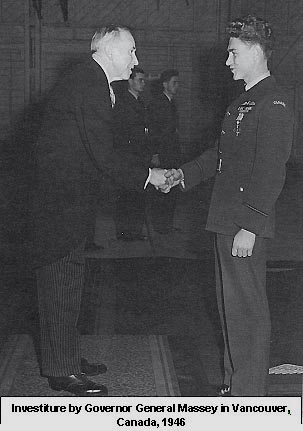
|

Courtesy of Veterans Affairs Canada. |
Brussels Evere was a marshalling point from which German aircrews that were shot down or otherwise captured were kept in custody pending being transported to other locations in the western world to serve their incarceration. During my times off while serving at this base, I used to visit with these personnel and shared goodies with them (cigarettes, chocolates or whatever I had), and most of them asked the same questions: "Why are we fighting you people? We should be fighting together against the Russians!"
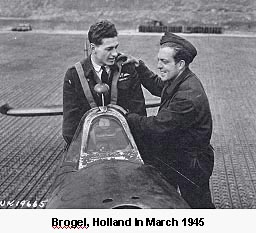
|

|
Spitfire pilots have their moments of glory to be sure, but much credit for winning the war must be handed to the crews of bomber command who endured hours of anguish en route to and from German cities such as Hamburg, Berlin, Regensberg [home of the Messerschmitts], Schweinfurt [ball bearings], Peenemunde [home of the rockets, missiles and wonder weapons], Ploesti [oil fields], Vemork near Oslo [heavy water for nuclear research], and many others, and delayed if not halted the research on and development of numerous 'wonder' weapons.
Historians tell us that as late as March 1945, [remember that V-E Day was May 8,1945], Germany had so many potentially destructive weapons being manufactured or planned, we now realize the value of the work the bombers did. The operational concepts of some of these new weapons were validated at least two years earlier. Among these weapons was a long-range Junkers Ju 390 bomber that actually penetrated to within twenty miles of New York City in 1943. The capability of delivering lethal ordnance, [military weapons], to distant targets against which there were no known cures or antidotes was clearly demonstrated. In the case of the V-2 and later multi-stage rockets, they travelled in excess of the speed of sound, reached 60 miles above the earth in their flight and gave no advance warning of their arrival. Towards the end of January 1945, Russian forces over-ran some worked out coal mines in Silesia and discovered secret factories where Tabun nerve gas and its derivatives Soman and Sarin, [the gas that was used in the Tokyo subway a few years ago], were being prepared and stockpiles of 100,000 bombs and one million artillery shells loaded with these gases were found. The Allies were appalled by this discovery, since there was no cure or antidote if exposed to these gases. One can conjecture about the ultimate disposition of these weapons, even to this day. The toxin Ricin, whose notoriety almost 60 years after the war is a threat to the world without vaccines or antidotes, is a derivative of these substances. Development of these weapons was one of the best kept secrets of the war.
Many of the furloughs enjoyed by the Allied Forces in the United Kingdom were spent in London, where most of the available amenities could be found, subject to rationing. I recall standing at Piccadilly Circus numerous times and observing American Bombers returning from their daylight raids, [Americans bombed during daytime, British bombed during night time] many of whom were barely above the rooftops. Many were struggling on fewer than four engines to remain airborne and were missing parts of wings, tails and had otherwise perforated fuselages. Unseen to observers was the carnage that must have existed within these aircraft from the wounded, dead and dying. Many of these aircraft must have been oozing with blood. The boys rarely talk about such things but they occurred also when Bomber Harris’s RAF and RCAF crews returned from their night raids to their bases scattered mostly in the rural midlands of the United Kingdom.
It was customary in the UK to listen to BBC radio each morning to be told that last night our Mosquito aircraft bombed Berlin and all of the aircraft returned safely. [Mosquitoes were very fast and usually were able to elude pursuing enemy fighters]. Towards the end of the war, none of the Mossies were returning, having become victims of the faster Messerschmitt 262 jets each armed with R4M rockets, four 30mm cannons and the EZ 42 automatic gyroscopic gunsights. Also a new aircraft type, the Heinkel He 219 night fighter, took a heavy toll of Mossies before its use was discontinued for obscure reasons. Hitler's intervention against the development of the Messerschmitt Me 262 as a superb fighter helped the Allies` cause immeasurably. In September, 1944, when Germany had only about forty 262's operational and when six of them destroyed fifteen American four engined bombers in 15 minutes, Generals Spaatz and Eisenhower reported that such losses could become unbearable in the near future. For each heavy Allied bomber aircraft lost there were 10 crew in American B17 Flying Fortresses and B 24 Liberators, and 7 in Lancasters and Halifaxes respectively. On March 31st, 1944, headlines four inches high announced that 95 of our aircraft were missing after a raid on Nuremberg the night before. The actual figure was about 120 lost when aircraft damaged beyond repair are included.
It was necessary to destroy the German war effort in 1945 against the protestations of the bleeding hearts of the day that contended that Dresden and other German cities should not have been firebombed when Germany was supposedly down and out. What happened on the 11th of September this year could have happened 56 years ago. The Germans had the capability to do it and during the last year of the war were probably desperate enough to try it. One can only ponder the consequences of a September 11th type of attack or worse during World War II against America, Britain and other countries whose soldiers were engaged in the fighting in Europe, while their countries, homes, and families were being devastated by deadly weapons of mass destruction which could have been delivered by aircraft, submarine or missile.
The Germans were masters at concealment, and by dispersing and moving their armament production facilities into abandoned mines, forest factories and new underground facilities, they were able in September 1944 to achieve their maximum fighter plane production of the war when 1800 units were built. Shortage of fuel and heavy operational losses of aircrew prevented the building of any significant reserves. Indeed, they were so short of fuel that they utilized cattle to tow some of their jet aircraft from the dispersal area to the take-off point to save fuel that would have been consumed in taxiing. Since the underground works were not vulnerable to bombing, it was necessary to destroy the cities where the workers lived to curtail production.
Why did we do what we did during the war? This is the question often asked by those who were not there. The emaciated faces and bodies of those at Belsen, Auschwitz and Buchenwald and the experiences of those at various prisoner of war camps or stalags tell the whole story.
Another group that deserves much credit for their contribution to the war effort was the merchant navy who were mauled by the subs and practically ignored by King and country for their efforts.
And for the ladies, tonight’s the night. Give that Bomber boy an extra special hug; he deserves it. And for the rest of us who made it back and as the twilight of our own years approaches, let us give our fallen comrades the remembrance they deserve.
A post war serial on television used the lines:
"There are 12 million stories in the Naked City".
This has been one of them.
Thank you.
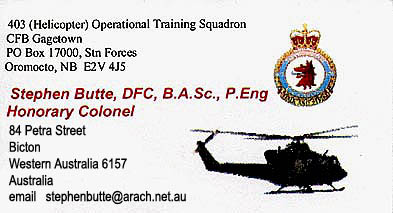
|

War Veterans of Michel and Natal The District of Sparwood created this site to pay tribute to those from my hometown of Michel-Natal, B.C. who served their country in war.
Coal Miners Memorial This site, created by Ron Venzi, is a memorial to the miners of Natal, Michel and Sparwood, B.C.
The Search for a Pilot’s History In this article which was published in the Jan/Feb 2003 edition of The Atlantic Canada Aviation Museum (ACAM) Newsletter, Mark Peapell, the former President of ACAM, describes how he researched my wartime career.
Canada's Air Force This is the official Department of National Defence website and it provides extensive information about the past and present Canadian Air Force. Features include an in-depth Timeline of World War II and retired fighter pilot Jock William's touching story A Flight Into Memory. Follow the link to the Air Force Association of Canada (AFAC) to access historian Hugh Halliday's list of RCAF Personnel Honours and Awards 1939-1945.
RCAF.com This informative site which is dedicated to all past and serving members of Canada's Armed Forces, has a wealth of information on the RCAF. For the wartime history of 403 Squadron, go to No. 403 Squadron City of Calgary: the War Years and for up to date information on 403 Squadron Gagetown, New Brunswick, go to No. 403 HelOTS Squadron: The Present.
|
To send Stephen an email Please click here or on the image at the right. |

|
Updated 8 August 2009